Lakonos and the nuances of its cultivation
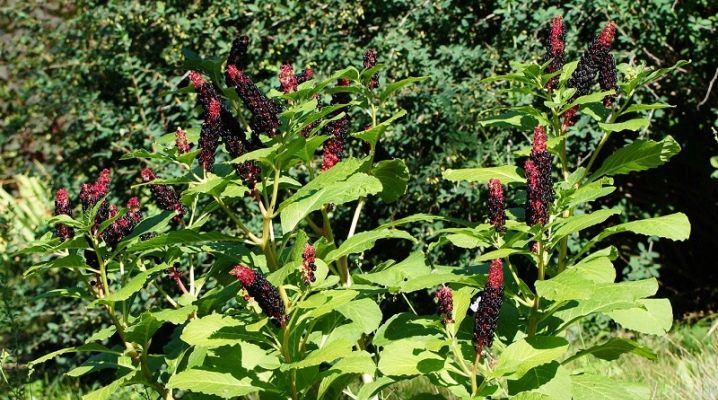
Lakonos belongs to perennial grasses, sometimes it is found in the form of a shrub, and tree-like forms are very rarely observed. The article will discuss this plant and the nuances of its cultivation.
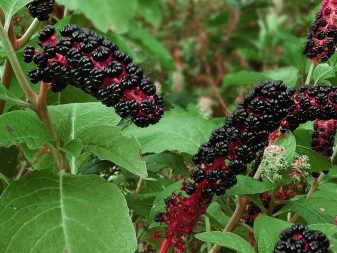
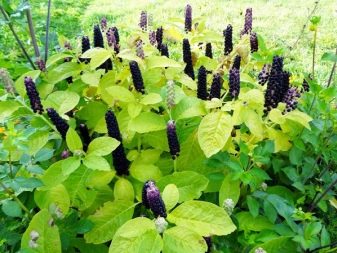
Description
Lakonos is a native of North America, the plant was brought to Eurasia by ships arriving from the New World. Today in the wild, besides the American continent, the grass can be found in the North Caucasus, in the Western Transcaucasia, on the territory of Azerbaijan. In Europe, lakonos began to be cultivated as a garden plant in the 18th century. Perennial easily runs wild, for this reason it is found in the form of weeds near people's homes, on the sides of roads. More than 20 species of lakonos are known, in our country only three are grown - berry, American and club-bearing. Before flowering, tall grass may look like weeds, albeit attractive, with large leaves, organized into a beautiful bush. When unusual long racemose inflorescences appear, the plant takes on a decorative appearance.
Lakonos (Phytolacca) is a herbal plant of the Lakonosov family. The sources use the second name - phytolacca. Perennial strongly branching, forms lush and large forms, some species grow up to 3 meters in diameter. The herb contains a thick taproot with a short but powerful rhizome. The total weight of the root system of an adult plant can be 10 kg. Thanks to this, the lakonos is always able to get nutrients for itself. The roots and shoots of the plant are toxic. Stems are thick, fleshy, in large species - woody, with a burgundy tint, their diameter is about 5 cm.The pale green shoots look thinner.
Leaves are opposite, simple, ovoid with a pointed end, sitting on strong, short petioles. Depending on the species, their length varies from 6 to 40 centimeters, and the width - from 3 to 10 cm. Shades of green also vary depending on the species. In addition, young foliage always looks brighter than the summer version, and autumn plates acquire a crimson tone. Starting from June, phytolacca produces peduncles (carpal inflorescences) from 10 to 30 cm long at the ends of the shoots. They contain many tiny flowers, 5 mm in diameter. The flowers are bisexual, with five sepals and many stamens (15-20 pieces).
Flowering brushes in appearance resemble chestnut inflorescences, bloom on the plant throughout the summer.
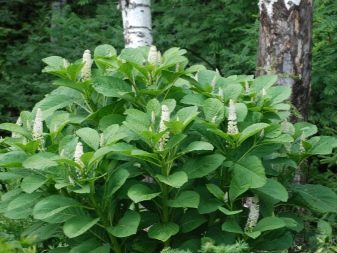

Since the end of August, in place of flowers, on a powerful rod, first pink, and then dark purple, shiny, almost black berry-shaped fruits are formed, resembling blackberries in shape. The ten-lobed fruit contains seeds inside. In autumn, the lakonos reaches its maximum decorative effect. A lush, herbaceous bush with large red leaves and glossy black fruits looks amazing. In winter, all aboveground parts of the phytolacca die off. The deeply seated root can easily tolerate frost. In the spring, the plant is reborn. Young shoots can be transplanted to obtain new grassy bushes.
It should be noted the characteristic of the poisonous properties of the herb. Not all species belong to completely toxic variants, for example, berry lakonos is characterized as conditionally poisonous. In small quantities, not only its fruits are eaten, but also leaves, roots, and green shoots.The roots and shoots of American phytolacca, on the contrary, are highly toxic, it is better to admire this plant from afar. The degree of poisonousness of the lakonos differs depending on the parts of the plants and on the season. The highest concentration of toxic substances is present in the root, the lowest in the berries. In early spring, young shoots are still slightly poisonous. The plant's toxicity peaks by the end of July, when light pink berries are already appearing, but it is still far from full ripening.
Phytolacca, in addition to decorativeness, is also valued as a medicinal plant, used in folk medicine and in the pharmaceutical industry in some countries. The herb is an excellent honey plant.
Non-toxic species are used in cooking by different peoples; berries, leaves, shoots and roots are used in dishes. The rich color of the berries is used as a dye for fabrics and young wine.
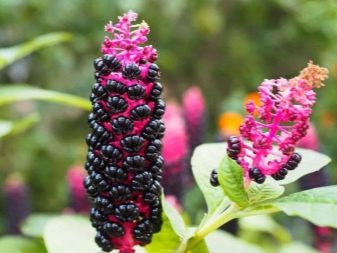
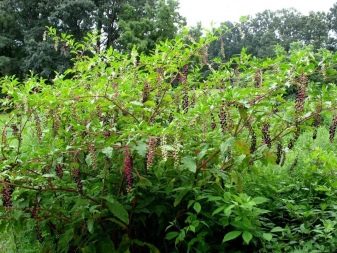
Views
Berry (Phytolacca acinosa)
The plant can also be found under other names - grape, edible, drupe, multicarp laconos. The herbaceous bush grows up to 1.5 m in height. It differs from the American species in erect peduncles. Contains elliptical leaves and white-greenish inflorescences. Of the three species growing in Russia, only berry is eaten.
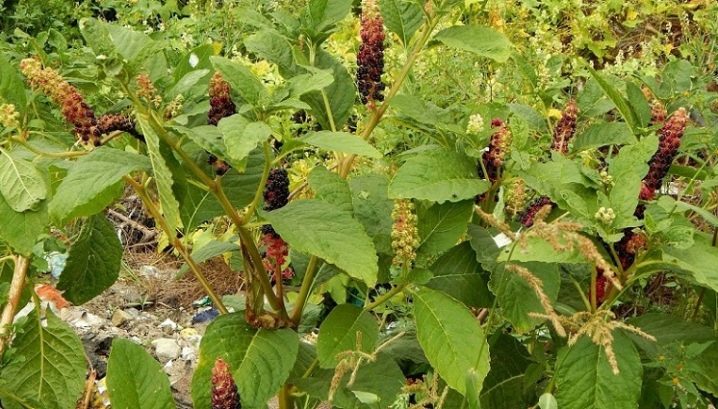
American (Phytolacca decandra)
The second name of the perennial is ten-stalk phytolacca. The most widespread and largest species, it grows up to 3 meters high. The root is short but powerful and poisonous like other parts of the plant. The inflorescences can reach 40 cm and look drooping.
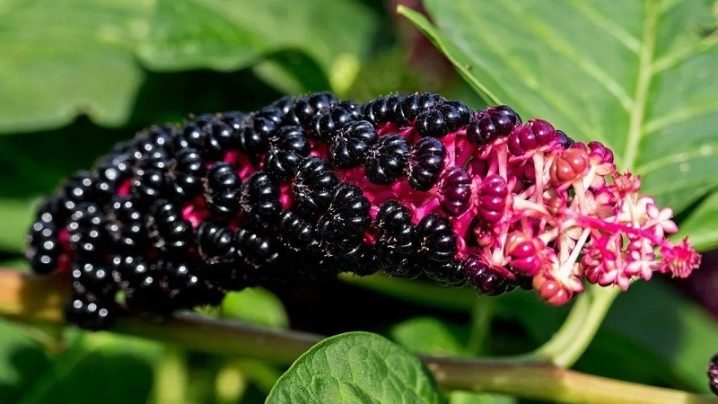
Claviferous (Phytolacca polyandra)
The sources use the second name - multi-lamellar. A beautiful variety of phytolacca, distinguished by bright crimson shades of peduncles. The glossy stem also contains a reddish tint. The plant has large leaves, reaching a length of 30 cm.
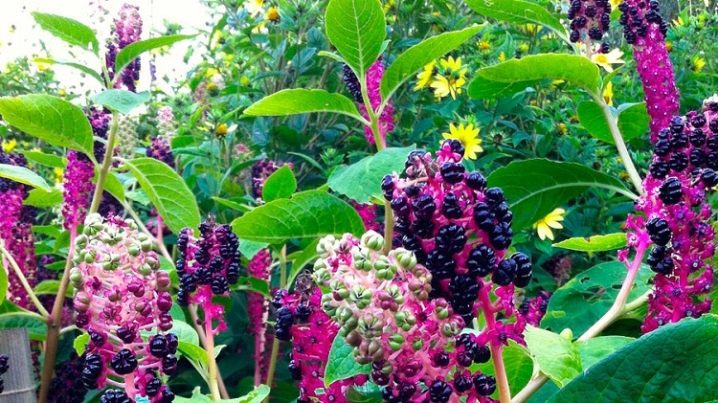
Landing
Although Lakonos is called the American weeds, it still has its own preferences in planting and growing. You need to find a suitable place in the garden, prepare the soil and plant the plant at the right time.
- Time for planting. Seedlings are planted in spring. Different regions have their own terms for planting. It is important that the frosts finally recede and the soil warms up to 8-15 degrees. Seeds are sown in spring and late autumn. Spring sowing is carried out after the irrecoverable departure of frosts, when the temperature on the ground does not drop below 4 degrees. For autumn sowing, planting material from freshly picked fruits is used. It is believed that planting a perennial in autumn is preferable, since the seeds are stratified in natural conditions. In the spring, when the sun thoroughly warms up the earth, shoots can be expected.
- Place on the site. When choosing a place for a lakonos, it should be borne in mind that a herb bush can grow up to 2-3 meters in diameter. This means that the distance between him and other cultures should be no less than these parameters. The plant is light-requiring, large in size and active fruiting can be expected by planting it in an open, sunny area of the garden. Phytolacca takes root well in partial shade, but under such conditions it grows low, with smaller leaves and a small number of fruits that may not have time to ripen before the onset of cold weather. The decorative properties of the plant directly depend on the amount of sunlight. Another nuance is important when choosing a place for planting a perennial - the absence of drafts. Lakonos should be planted in a windless part of the garden, protected by a fence or buildings. But the buildings should be at a sufficient distance so as not to cast a shadow on the photophilous plant.
- Ground requirements. The power of the root system allows the lakonos to grow on any soil, but on depleted soil it will form small, weak, inexpressive, incapable of seed ripening. It looks like a weed, not a spectacular plant designed to decorate gardens and parks.You can get delicious decorative properties only on nutritious chernozems. Light peaty-sandy or loamy soils with neutral acidity are also suitable for Lakonos. If the composition of the soil is different on the site, it needs to be modified - dilute the heavy clay soil with sand, reduce the high acidity with dolomite mineral.
At the site chosen for planting, it is necessary to organize a drainage layer, and then cover it with a nutritious soil, since the fleshy roots of the perennial easily rot during stagnant moisture.


Planting methods
Phytolacca can be planted directly into open ground by sowing seeds. Or, first grow the seedlings on the windowsill, and then transplant them to the site.
- Seeds. Seeds are sown on the prepared site in spring or autumn (before winter). Before spring sowing, the planting material, mixed with sand, is sent to the refrigerator for 1-2 months to acquire frost-resistant properties. For several days before planting, they are kept in a humid environment to help hatch. When the frost has completely receded, grooves are made on the site with a depth of 2 cm, two seeds are lowered into them every 1-1.5 m. Those who are not sure of their seeds, the groove is planted denser, and after a while the extra seedlings break through. The planted seeds should be lightly sprinkled with earth and watered. The seed that is planted before winter does not need preparation. Stratification occurs naturally. To prevent the seeds from freezing, they are well mulched with a thick layer of autumn foliage.
- Seedlings. Lakonos does not like diving, so that the plant does not hurt after transplantation, it is carried out together with an earthen lump. And for this you need to grow seedlings in peat cups. Together with them, when the time comes, the plant will go into open ground. Seedlings are planted at home in March. Seeds are prepared in the same way as for spring soil sowing - they are hardened, soaked for pecking. To disinfect the seed, before planting, it is kept in a manganese solution, and in order for the seedlings to rise more actively, the seeds are dipped for 5-10 minutes in a growth stimulator. Peat cups are placed on a tray and sent to the windowsill. It remains only to water the seedlings in a timely manner, avoiding dry clumping of the soil. In May, when the seedlings grow up, they are transplanted into open ground in a prepared area.
The distance between the shoots is maintained depending on the variety, for example, the American phytolacca will need more than a meter, and for the club-bearing species, 60-70 cm is enough.
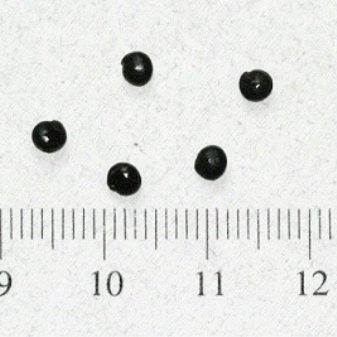
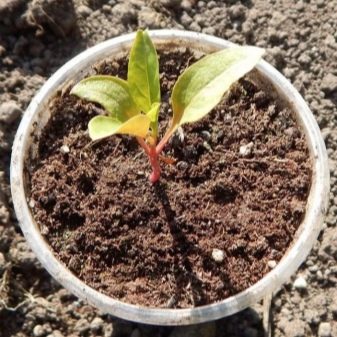
Care
It depends on the care how effective the herbal shrub will turn out. A large plant with large leaves and many inflorescences can only grow from a caring gardener. Let us dwell in more detail on the stages of leaving.
- Watering. Lakonos is a moisture-loving plant with wide leaves that quickly evaporate moisture, especially on a hot day. If you skip watering, the leaves will soften, and the bush will lose its attractiveness, during the dry period the grass dies. But it should be remembered that phytolacca does not belong to marsh plants, and the root system tolerates stagnant moisture as badly as drought. In dry weather, watering should be carried out daily - in the morning or in the evening. During irrigation, you can remove the weeds around the bush. Wet soil must be mulched to prevent the topsoil from drying out.
- Top dressing. Phytolacca blooms all summer and needs regular organic feeding to support long-term flowering. Therefore, twice a month, all spring and summer, it is necessary to pour a bucket of mullein water solution under the root. Young plants, 1-2 years old, are especially sensitive to soil depletion. Their root system is not yet sufficiently developed to deliver nutrients from deep soil layers. In the spring, perennials can be fed with complex mineral fertilizers.
- Transfer. We have already noted that phytolacca does not like transplanting, since its overgrown root system is easily damaged. It is better not to be mistaken with the place initially and to plant the plant correctly. If, nevertheless, a transplant is needed, young herbaceous bushes, with not yet formed roots, tolerate it more easily. You need to transplant the plant on a summer evening or in cloudy weather using the transshipment method. Drainage should be placed in the prepared hole; light fertile soil should be prepared for falling asleep. The plant is immersed in the pit along with an earthen clod. After watering, the surface around the bush is sprinkled with dry earth or peat.
- Pruning. The plant does not need decorative pruning, as it is able to form beautiful forms by itself. During the summer, to improve the appearance, only dry small parts of the bush can be removed. In autumn, at the end of the growing season, the lakonos is cut off completely. If this is not done, the root will suffer from the frozen aerial part and will not be able to give fresh shoots in spring. After cutting, the surface of the earth above the root is well covered with peat, dry foliage and grass. The litter should be at least 10 cm long. In the spring it should be removed to allow the plant to develop.
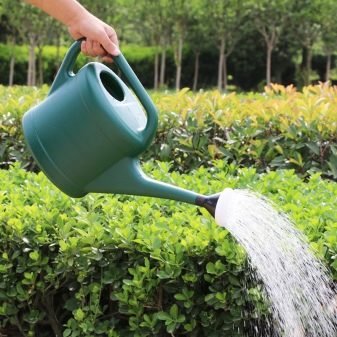
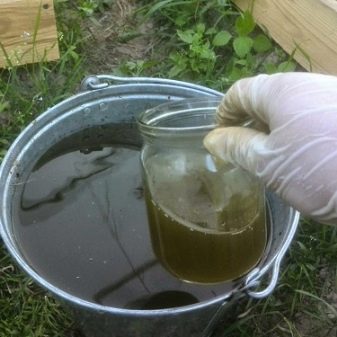
Reproduction
Phytolacca reproduces by seeds and root division. Let's consider each method separately.
- Rhizome. This method is only suitable for dividing young bushes no more than 5 years old. Over time, the rhizome of the lakonos grows in depth and in breadth, gaining a lot of weight. It will be extremely difficult to divide such a giant without harming the plant. There should be several buds on the rhizome, separated from the mother bush. You can buy a spine in specialized shopping centers. It is planted on the site in late April - early May.
- Seeds. The plant itself perfectly reproduces by self-seeding, when it comes time to fall off berries containing seeds. Unfortunately, seed material quickly loses its germination, and is suitable for sowing only for a year, so look for the date of collection on the bag when you buy it.
In open ground, as already noted, seeds are sown in autumn and spring, and in autumn sowing can be done with fresh (together with fruits), just harvested material.
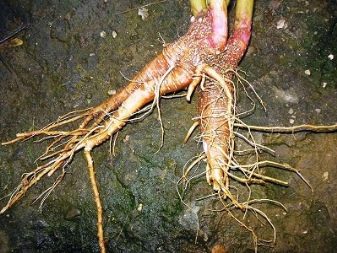
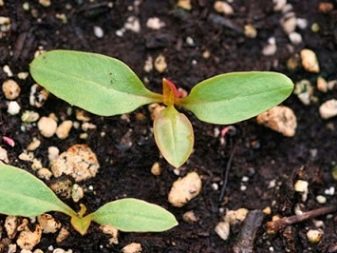
Diseases and pests
Lakonos is unique in its resistance to disease and pests. Its chemical composition provides the perennial with strong bactericidal and antifungal properties. The toxicity and peculiar smell scare away parasites. Phytolacca can help not only itself, but also neighboring plants, which is what gardeners use by planting the most vulnerable crops next to it.
Application in landscape design
Lakonos is decorative at any time of the year, excluding winter.
- In spring it attracts with bright fresh large foliage.
- All summer long it is decorated with long inflorescences, similar to the "candles" of chestnut.
- In autumn, unusual fruit formations and red leaves are delightful.
Phytolacca in landscape design is used in different ways:
- as a solitary exotic herbaceous bush;
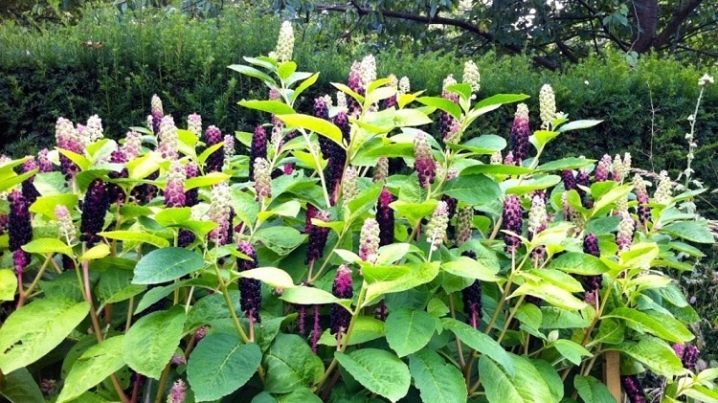
- thanks to its massif, lakonos can become an accent spot in a composition with other flowers;
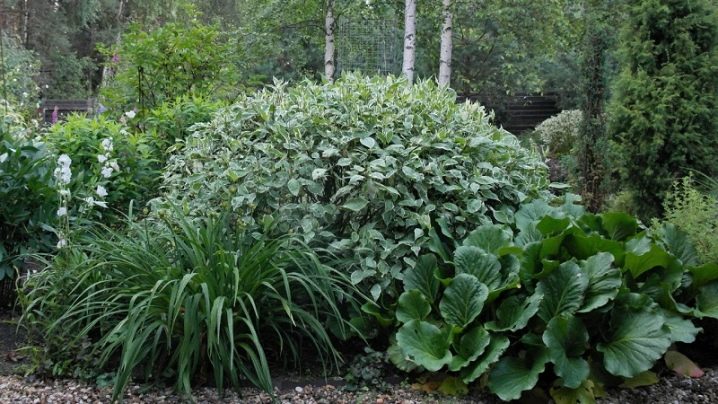
- it is used as a landscape plant;
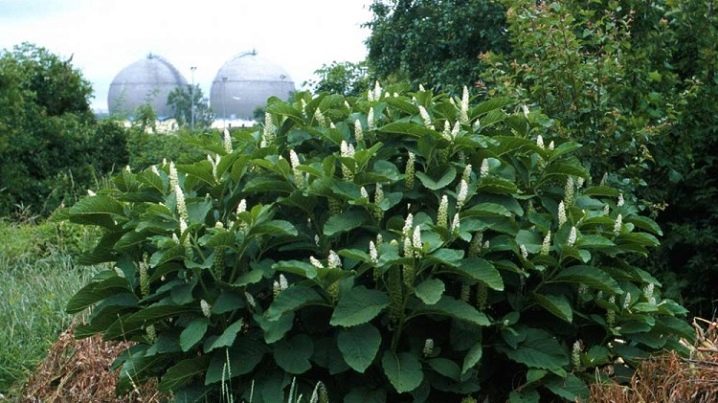
- for decorating flower beds;

- an overgrown perennial can hide old buildings;
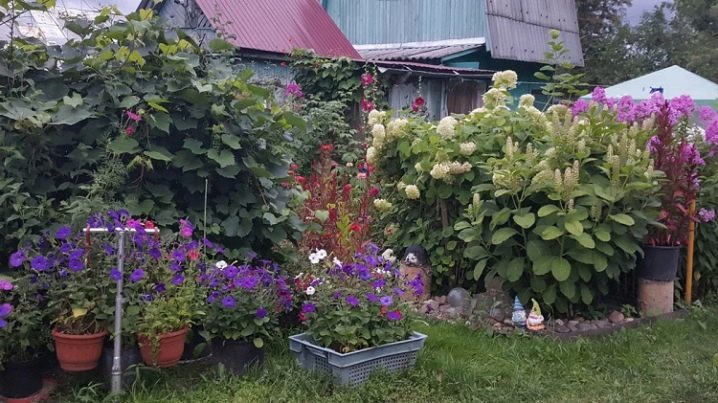
- the plant perfectly decorates garden paths.
And many more applications can be found for this unusual perennial in our gardens and parks.
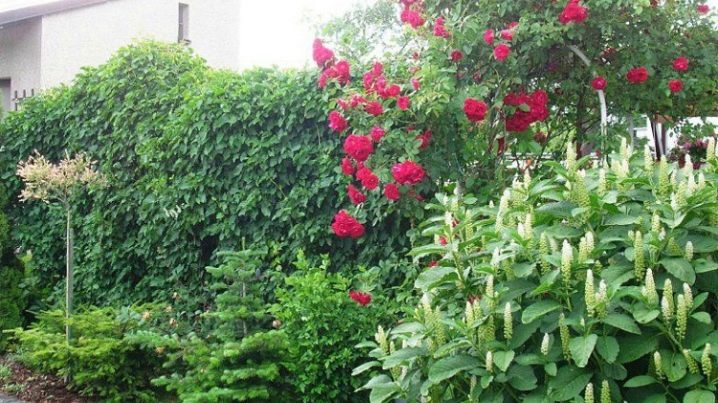













The comment was sent successfully.